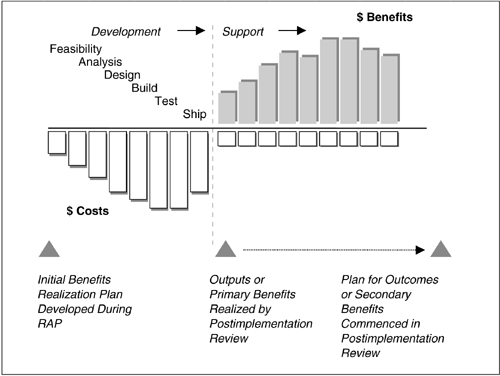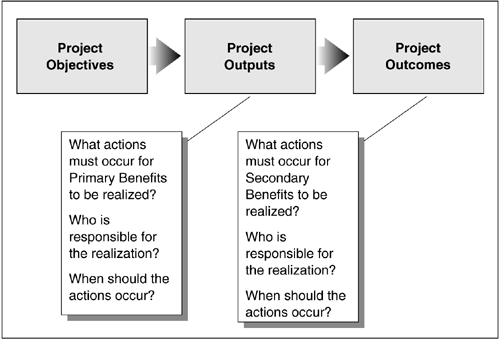Benefits Realization Planning
| As we have discussed throughout this book, one of the major distinctions between traditional project management and our group 's approach is the issue of benefits analysis and realization. As discussed earlier, the traditional approach to costbenefit analysis (and project management, in general) did not involve business clients in any meaningful manner. The "arm's length" model of IT as a service provider left the business people alone to determine and garnish benefits. As a result, through lack of education and lack of effective costbenefit analysis models and accountability, many business people have sponsored projects that eventually did not provide the benefits expected. A typical example of this is where a project is justified based on the elimination of five staff positions, but no one is made accountable for the redeployment of the five people currently in those positions . The process of benefits realization planning is critical to eXtreme project management and involves a partnership among the project team, service providers, clients, and, in many cases, external stakeholders. Benefits realization planning has become a critical issue in our project management approaches. It involves a complex examination of both the projected estimated benefits and costs of the project during the initial RAP sessions which, as shown in Figure 18.7, are conducted during the project initiation, feasibility, and requirements analysis processes. Figure 18.7. Benefits realization events As we discussed in Chapter 9, the conduct of the added value analysis would normally occur interactively with the definition of the project's scope, objectives, related projects, and stakeholders. This is critical, as many of the project's stakeholders and related projects would have a role to play in the benefit realization planning. Again, it should be emphasized that the involvement of key stakeholders and project managers of related projects in the benefits realization planning process is vital . Not only are the stakeholders expected to commit to both the garnishing of the benefits and the time frame for the garnishing, but they will assist the project manager in both identifying and estimating benefits and in establishing the validity of the added value chain. Of course, the analysis shown in Figure 18.8 should have occurred in the initial RAP sessions for your project. Figure 18.8. Benefits realization planning analysis
Using the techniques and approaches introduced in Chapter 9, the project manager, team members , and stakeholders together would undertake the following steps:
The Benefits Realization PlanFigure 18.9 shows a sample benefits realization planning document for completion for each objective. Figure 18.9. Benefits realization agreement This agreement would be completed and signed for each project objective during Step 2 of the RAP process and the completed benefits realization planning forms would be assembled into the benefits realization plan and submitted as part of the business case to the project sponsor and steering committee at the end of the project initiation phase.
During the project, as for other key project management information, you, your team, and your critical stakeholders must monitor the project value analysis figures as more detailed costing and estimates become available. Of course, any data that alters the project value analysis should be immediately reviewed and the new project value analysis submitted to the project sponsor for review and action. The Project Sponsor's RoleThe role of the project sponsor is vital in contemporary project management. In benefits realization, the project sponsor has a particularly important role. As discussed earlier, it is the nature of the added value chain that the project manager and team are responsible for achieving and realizing primary or direct benefits (outputs). The project sponsor and project stakeholders are responsible for achieving and realizing secondary or indirect benefits ( outcomes ). For example, in the office automation project, the team is accountable for developing and installing the appropriate OA technology and software. The people using the OA technology (i.e., the stakeholders) are accountable for using the OA technology and the avoid cost benefits. In the process of benefits realization planning, the project sponsor is responsible and accountable for all benefits (primary and secondary). As a result, the sponsor must ensure that all stakeholders are involved and committed to the benefits realization and must undertake whatever action is required to ensure that stakeholders have "bought in" and are held accountable for their role in realization. Benefits ReviewsAs shown in Figure 18.7, during the postimplementation review stage of the system development process, the actual implementation of the benefits realization plan is commenced. Using the benefits realization agreements completed in the project planning sessions (Figure 18.9), the project sponsor, project manager, and key stakeholders develop various timetables for the realization of the benefits. To ensure that this happens, the project sponsor must also assemble a benefits realization steering committee (or similar management group) that represents all major stakeholder groups. Depending on the nature of the project and the specific benefits curve, there should be a series of benefit review points determined at which the progress of the realization process can be monitored and evaluated. At a minimum, these reviews should occur quarterly.
|
EAN: 2147483647
Pages: 136



